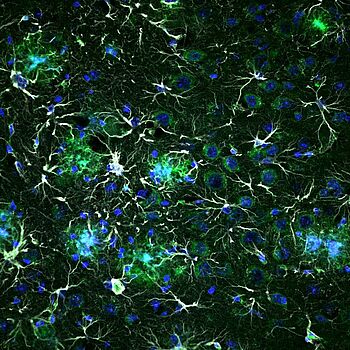In a way, the brain resembles a large symphonic orchestra, whereby although the various instruments play together, each assumes a special part. Accordingly, the brain consists of nerve cells, also called “neurons”, that are woven into a network in which they relay signals to one another. On the other hand, so-called glial cells are also equally important for brain function. These cells were once regarded as mere connective tissue of the brain. However, it is now known that they assume tasks that are far more complex than previously thought. One prominent member of this versatile family of glial cells are the astrocytes.
“Astrocytes have various functions in the brain. For example, they supply the neurons with nutrients, but they also dispose waste products of metabolism“, explains Professor Gabor Petzold, who leads a research group at the Bonn site of the DZNE and also supervises the Neurovascular Unit at the University Hospital Bonn. „In addition, they influence the communication of neurons with one another, and are involved in the control of cerebral blood flow.”
Alzheimer’s disease alters the astrocytes
It has long been known that astrocytes change their shapes as a consequence of Alzheimer’s. Cells located near the “plaques”, as the protein deposits typical for this disease are called, grow in size and form additional extensions. However, until know it was largely unclear how these changes affect the function of astrocytes.
Thus, Petzold and his colleagues studied mice whose brains exhibited the typical protein deposits of Alzheimer’s. They discovered that the calcium metabolism of astrocytes in the vicinity of plaques was disturbed. Calcium plays an important role as a regulator of cellular function and metabolism. “The astrocytes were hyperactive. This means that calcium levels in these cells could suddenly rise. We also noted that this effect often travelled to neighbouring astrocytes, causing so-called calcium waves. The effect is quite similar to throwing a stone into water,” Petzold notes. “Normal astrocytes, in contrast, only rarely exhibit these variations in the concentration of calcium.”
Energy carriers with a signal effect
These fluctuations were caused by the actions of a cellular molecule named ATP. When the researchers blocked its release with the help of drugs, the activity of the astrocytes normalized. The same effect was achieved when the scientists disabled a specific receptor for these molecules. As Petzold’s team determined, this receptor was present in unusually high numbers on the surface of astrocytes in the vicinity of plaques. This circumstance made the cells particularly susceptive.
“ATP and similar molecules normally supply the cells with energy. However, it has already been known that they can also act as messenger molecules that can trigger specific reactions“, Petzold explains. “Although these molecules occur in most cell tissues, it is assumed that their release is increased in the vicinity of the plaques. We could show that this causes the astrocytes to switch into hyperactivity. The signalling pathway is mediated by a special receptor on the cell surface of astrocytes.”
An influence on blood flow
It is still uncertain whether the astrocytes’ hyperactivity constitutes a protective defence reaction or whether it is associated with negative consequences. However, the current study shows that the calcium waves may in some cases be associated with local changes in brain perfusion. “This is interesting, because there have long been indications that Alzheimer’s has a vascular component. Alterations of blood vessels and blood flow appear to play an important role”, says Petzold.
According to the Bonn scientist the current study could open up new avenues for therapy: “Our investigations demonstrate that it is possible to mitigate the hyperactivity of these cells. This could point to a novel approach for treatment. It might perhaps also be possible to modify the course of the disease with the help of suitable pharmaceuticals.”
So far, the scientist clarifies, the signalling pathways were studied at the level of the cellular network in the brain. In future studies, Petzold and his colleagues intend to investigate what effect the inhibition of hyperactivity has on disease symptoms.
Original publication
Metabotropic P2Y1 receptor signalling mediates astrocytic hyperactivity in vivo in an Alzheimer’s disease mouse model
Andrea Delekate, Martina Füchtemeier, Toni Schumacher, Cordula Ulbrich, Marco Foddis, and Gabor C. Petzold.
Nature Communications, 2014, doi: 10.1038/ncomms6422

